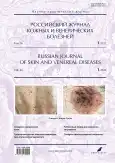Photogallery. Follicular occlusion syndrome
- Authors: Teplyuk N.P.1, Pirogova A.S.1, Svistunova D.A.2
-
Affiliations:
- I.M. Sechenov First Moscow State Medical University (Sechenov University)
- Saratov State Medical University named after V. I. Razumovsky
- Issue: Vol 26, No 1 (2023)
- Pages: 95-100
- Section: PHOTO GALLERY
- URL: https://journals.rcsi.science/1560-9588/article/view/132599
- DOI: https://doi.org/10.17816/dv119832
- ID: 132599
Cite item
Abstract
Hidradenitis suppurativa, dissecting cellulitis of the scalp, acne conglobata and pilonidal sinus ― are four diseases united by similar clinical findings and common mechanisms of pathogenesis. These conditions often coexist. The primer pathogenetic event is stratum corneum thickening and keratin plugging of the hair follicle ductal isthmus. The discovery of this mechanism led to association of all the diseases with the term "follicular occlusion syndrome". If three nosologies are detected follicular occlusion triad is diagnosed, if four are present ― follicular occlusion tetrad.
We present a photogallery on this problem.
Full Text
##article.viewOnOriginalSite##About the authors
Natalia P. Teplyuk
I.M. Sechenov First Moscow State Medical University (Sechenov University)
Email: teplyukn@gmail.com
ORCID iD: 0000-0002-5800-4800
SPIN-code: 8013-3256
Russian Federation, Moscow
Anna S. Pirogova
I.M. Sechenov First Moscow State Medical University (Sechenov University)
Email: annese@mail.ru
ORCID iD: 0000-0002-2246-1321
SPIN-code: 1419-2147
Russian Federation, Moscow
Daria A. Svistunova
Saratov State Medical University named after V. I. Razumovsky
Author for correspondence.
Email: teplyukn@gmail.com
Russian Federation, Saratov
References
Supplementary files


















